|
RGB LED PWM Driver Troubleshooting Before starting
these checks, disconnect the power to the board and remove the PIC from the socket.
Store it carefully.
Are you using a 12 volt regulated
DC power supply? If not you need to obtain the correct power
supply before testing further.
Connect the external 12 Volt DC
regulated power supply to the circuit.
Once the PIC has been removed from the
socket, there is nothing driving the MOSFET transistors so the LEDs
may turn on/off or flicker. This is normal.
|
| Power
Supply Test Step 1
Measure the output voltage from the
Power Supply without having it connected to the circuit. This should
be about 12 volts (11.8 to 12.8 volts is acceptable)
Step 2
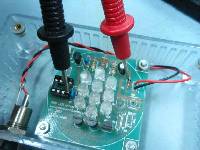
Measure the voltage between Ground
and the 12 volt supply at the cathode end of D1. (pin 8 of the IC
socket is at Ground this is a good place to measure from)
This should be >11.2 volts,
if it is goto Step 2.
If it is not then possible
causes are:
- faulty diode D1
- short circuit or solder bridge
somewhere on the PCB
- faulty PSU
Step 2
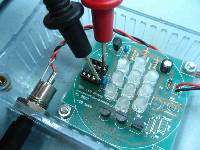
Measure the 5 volt supply between
pins 1 and 8 at the IC socket. Pin1 should be +5 Volts
relative to Pin8 (Ground)
Between 4.8 and 5.2 volts is
acceptable
If it is not then possible
causes are:
- short circuit or solder bridge
- U2 voltage regulator faulty
- U2 voltage regulator installed
wrong way round (if it has been installed the wrong way you
will need to replace it. DO NOT reuse it)
|
|
| Test each
column of LEDs by connecting the cathode of the LED nearest the
MOSFET transistors to Ground. You do not need to remove the MOSFETs
to carry out this test. DO
NOT attempt to test other LEDs in the column by grounding their
respective cathode (you may damage or destroy the LEDs even if they
had been working)
The LEDs should light when the
cathode is connected to ground If they do not light and there
is >11.2 volts at D1 then possible causes are:
- one or more LEDs installed the
wrong way round (cathode and anode reversed)
- one or more LEDs are faulty
- the LED current limiting
resistor (RLED, GLED, BLED) is the wrong value
- bad solder joints
|
| MOSFET
Transistor Test
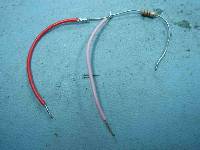
Make up a test lead as shown above.
I used a 1Kohm resistor; you can use any value from 100ohms to
33Kohms, it's not critical
Solder the free end of the resistor
to Ground, a good place to pick this up is the lead of the switch
SW1 as shown below. |
|
|
Leave the red wire disconnected.
Touch the pink wire onto the IC socket
pins 5,6 and 7, corresponding to the Blue, Green and Red LED
columns.
If the LEDs are on, they should
turn off when the wire is touched on the pin, if they are off they
should remain off.
If one or more LED columns remain
on when this test is carried out possible causes are:
a) short between the source and
drain terminals or drain and ground. Check solder joints as
the leads of the MOSFET are close together and you may have a solder
bridge.
b) the respective MOSFET has failed
and needs replacing.
This mode of failure is normally
caused by static discharge on the MOSFET gate terminal damaging the
gate insulation. Be sure to take proper antistatic handling
precaution when replacing it.
|
If the LEDs passed the Turn Off Test
you can carry out the Turn On Test
Connect the red wire to +5 volts.
Pin 1 of the IC socket is at 5 volts so use this.
Now repeat the previous step
touching the pink wire on to pins 5,6 and 7. Each LED column
should light as the corresponding pin is touched. (make sure
the red wire remains connected to +5 volts).
If they remain on after you touched
the pin, you can go back to the previous step and you should be able
to turn them off again
If one or more columns does not
turn on AND the LEDs worked when the LED Test was carried out
then the corresponding MOSFET has failed. |
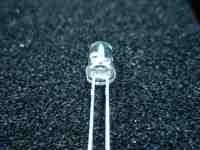
The cathode is normally denoted by a
flat on the body of the LED. I have seen LEDs (bought on eBay) where
this is not the case so it is worth testing one LED of each colour
to verify it.
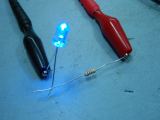
To check which lead of the LED is
the cathode use a 150ohm resistor in series with LED and connect to
a 5 volt test voltage. When the LED lights, the lead connected
to the negative end of the 5 volt supply is the cathode.
If the LED doesn't light either way
round it is most likely faulty. Test other LEDs to make sure
the test circuit is working before discarding it.
|
|